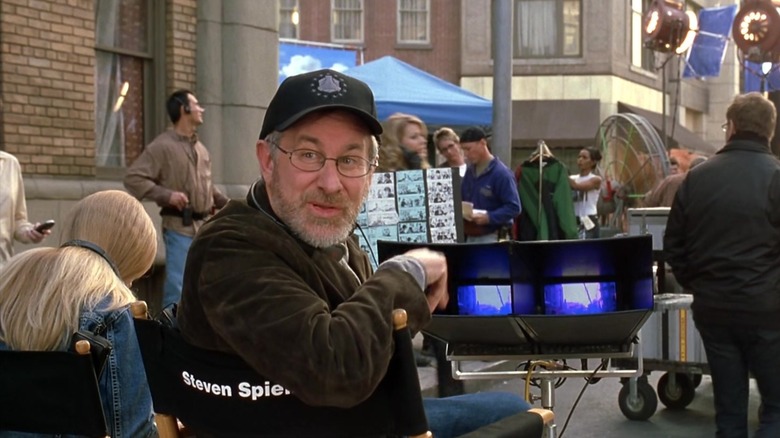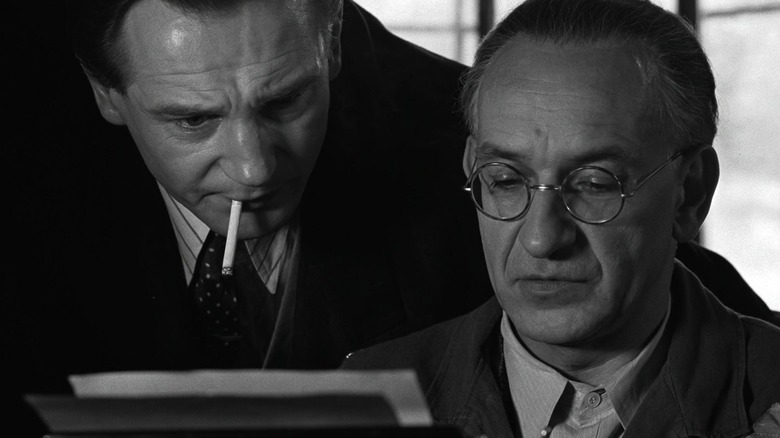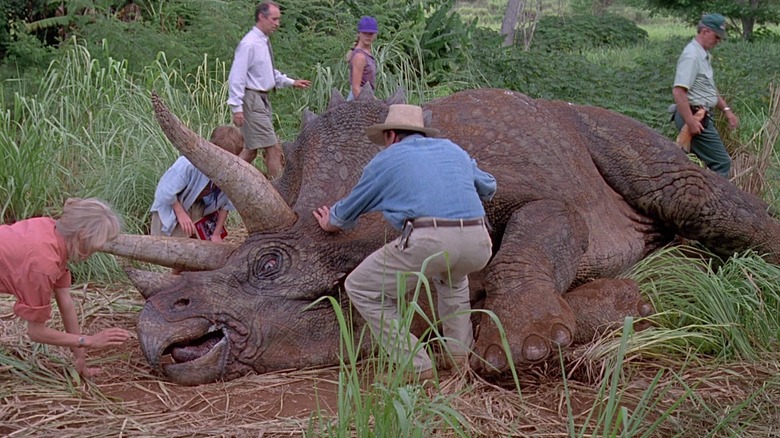Steven Spielberg's Best Movie, According To IMDb
One must be wary of the rating systems on IMDb. As one can see from the website's list of the 250 highest-rated movies (which is selected by its users), IMDb tends to favor ultra-masculine stories centering on criminals, cops, or soldiers. The top-rated film on its list is Frank Darabont's "The Shawshank Redemption," a 1994 drama about prisoners. Next is Francis Ford Coppola's mafia epic "The Godfather," followed by Christopher Nolan's superhero flick "The Dark Knight." Also hovering near the top are films like "Fight Club," "The Matrix," "12 Angry Men," "Pulp Fiction," and "The Good, the Bad and the Ugly." These are all excellent films, mind you, but when clustered together, they reveal something about the taste of the average IMDb user: Crime, violence, and male protagonists all seem to rule the roost. In short, the list is very basic.
To be fair, though, when taken individually, many of those films are indeed some of the best ever made. You will not hear me making a case against Milos Forman's "One Flew Over the Cuckoo's Nest" or "12 Angry Men." And I will certainly cast no aspersions toward Steven Spielberg's 1993 masterpiece "Schindler's List," which is the director's highest-ranked movie on IMDb.
Despite the action-and-crime-forward bent of IMDb's top 250, it may be surprising to learn that "Schindler's List" outranks Spielberg's well-known action bonanzas. Indeed, his 1975 ur-blockbuster "Jaws" only has 8.1 stars (out of 10) based on 669,000 votes, while "Jurassic Park" only has 8.2 (based on 1.1 million). Elsewhere, his 1989 sequel "Indiana Jones and the Last Crusade" is tied with "Jurassic Park" with an 8.2, but based on only 842,000 votes, while his celebrated "Raiders of the Lost Ark" has an 8.4 (based on 1.1 million votes). His second highest-rated directorial effort is his WWII picture "Saving Private Ryan" (8.6 from 1.6 million votes), ranking below "Schindler's List" (9.0 from 1.5 million votes).
IMDb users love Schindler's List
"Schindler's List," to remind readers, told the story of Oskar Schindler (Liam Neeson), a German industrialist who, during World War II, famously employed hundreds of Polish Jews in his factories as a specific means to shield them from the Nazis. At the beginning of the movie, Schindler is portrayed as being somewhat unscrupulous, caring only about making his factories profitable during wartime. As the film progresses, however, Schindler's closest associate, Itzhak Stern (Ben Kingsley), begins to convince him that he is actually saving lives by employing "essential" Jewish workers. Hence, he begins to employ as many people as he can (ultimately making a list of 1,100 names with Stern), arguing that they are needed for the war effort.
The film is stark and unflinching. It depicts some of the harshest elements of being starved and tortured in a concentration camp, the true monstrousness of the Nazi party, and the horrid suffering the Nazis inflicted on the world. Over Universal's objections, Spielberg shot the movie in black-and-white, removing any sense of "glitz" from the proceedings. Spielberg was, at the time, mostly known for action pictures and sentimentality ("The Color Purple" notwithstanding). But with "Schindler's List," it felt like he was finally ready to grow up as a filmmaker.
Neeson was nominated for an Oscar for his performance in the film, as was his co-star Ralph Fiennes, who played the heartless Nazi Amon Göth. The movie won the Academy Awards for Best Picture, Best Director, Best Screenplay, Best Score, Best Editing, Best Cinematography, and Best Art Direction that year, effectively smoking the competition. It's also worth remembering that the film was a sizable blockbuster, earning over $322 million on its $25 million budget.
Steven Spielberg made Schindler's List and Jurassic Park in the same year
1993 was a wild year for blockbusters. Movies like "The Firm," "Mrs. Doubtfire," "The Fugitive," "Indecent Proposal," and "In the Line of Fire" were among the highest-grossing films of the year, suggesting that audiences preferred more diverse entertainments in the 1990s. The highest-grossing film of the year, though, was Spielberg's own "Jurassic Park," which made over a billion dollars on its $65 million budget.
It's also wild to ponder how busy Spielberg was that year. "Jurassic Park" underwent filming from late August 1992 and moved through various locations around the globe before finishing on November 30. It was, as legend has it, 12 days ahead of schedule and under budget. Spielberg ceded certain aspects of the "Jurassic" post-production (mostly sound) to his friend and "Star Wars" guru George Lucas so that he could begin setting up "List." Spielberg would evidently spend his days in Poland attentively assembling "Schindler's List" and then get back to work editing "Jurassic Park" at night. Talk about tonal whiplash; Spielberg had to keep dinosaur mayhem and the Holocaust in his mind simultaneously.
"Schindler's List" began shooting on March 1, 1993. In fact, Spielberg was still filming "List" when "Jurassic Park" hit theaters that year on June 11. The former then wrapped and completed its post-production swiftly, all in time for a theatrical premiere the following December.
After that, Spielberg only briefly rested. He spent a few years setting up DreamWorks with Jeffrey Katzenberg and David Geffen, all the while serving as an executive producer on many, many movies ("The Flintstones," "Casper," "Twister") and varied TV projects. He then proceeded to direct "The Lost World: Jurassic Park" and "Amistad" in rapid succession, with both films arriving in 1997. I hope he had a chance to take a vacation at some point.


